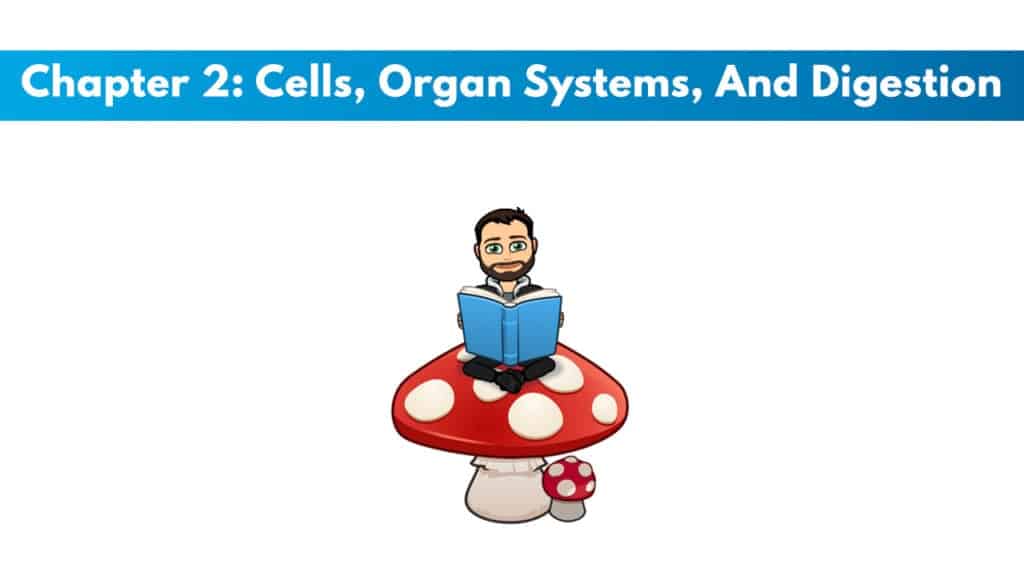
If you have not yet signed up for the ISSA Nutritionist certification, you can get it here for free as part of a special bundle.
Get your copy of the ISSA Nutritionist exam cheat sheet. It helps immensely for studying for the exam.
My PTP students report cutting their ISSA Nutritionist study time and effort in half with Trainer Academy.
Benefit from the Exam Pass Guarantee and Retake Fee Guarantee. Plus, take advantage of my current discount code PTPJULY for 50% off the MVP Program (Ends July 7th, 2025).
Try it out for free here to see if it’s right for you, or read my detailed review for further insights.
Chapter Goals:
- Know the structure and function of the animal cell.
- Be able to tell the differences between the various types of cells in the body.
- Know the differences between the various cell types in the body.
- Be able to discuss the aspects of the human digestive system and its functions.
Introduction
The human cell is considered to be the building block of life, and in the human body, we have trillions of these cells.
The cells will be used for structure, absorption of nutrients, generation of energy, movement of waste products, and performance of specialized functions essential for life.
The function and makeup will be dependent on the location of the cells.
Cell Composition
Cells comprise water and inorganic and organic molecules, with water being around 70% of the cell’s mass.
Fats, carbs, and proteins (the three main macronutrients) are all present in some form within cells.
A basic animal cell comprises a cell wall, cytoplasm, and a nucleus.
The cytoplasm hosts the organelles, which are the structures that perform specialized metabolic tasks.
The organelles include:
- Nucleolus
- Nucleus
- Ribosome
- Vesicle
- Rough ER
- Smooth ER
- Golgi apparatus
- Centriole
- Mitochondria
- Lysosome
- Peroxisome
- Microtubule
Structural Composition
The outside structure of the cell membrane is needed for life as we know it. It serves for the protection of the cell, and it also allows them to interact with other cells.
A membrane encloses each cell and is embedded with proteins, allowing things to cross this lipid bilayer.
The proteins comprise around 60% of the cell membrane; the rest are fats.
Human cell types
The body is made up of many cell types, and they all have quite specific functions. In total, we have around 200 types of cells in an adult human.
Shortly following the fertilization of human eggs by sperm cells, a 70 – 100 cell organism known as a blastocyst is made. This takes place around five days from conception, and the cells are, for the most part, undifferentiated. From that point on, they will change their roles and functions.
Some of the most prevalent human cell types are:
- Stem cell
- Red blood cell
- White blood cell
- Platelet
- Nerve cell
- Neurological cell
- Muscle cell
- Cartilage cell
- Bone cell
- Skin cell
- Endothelial cell
- Epithelial cell
- Adipose cell
- Sex cell
Tissues
Human tissues are groups of cells that function together to perform some grander task. We break this down into four categories:
Epithelial tissue
The epithelial tissue cells line the cavities of the body, so this is where the epithelial tissues are.
Sheets of these cells form the epidermis layer of skin and line the various tracts throughout the body.
These tissues may be defined by the types of epithelial cells within. They can be squamous, cuboidal, or columnar.
In addition, the epithelial cells may be transitional, glandular, simple, or stratified.
Connective tissue
This is any tissue that supports, connects, or binds another tissue in the body.
We can divide these connective tissues as being loose, dense, or specialized.
The loose connective tissue is made out of collagen, elastin, and reticular fibers and holds the organs in their place.
Dense connective tissues are made of the same components as the last, and they make up the tendons and ligaments that serve to connect muscle to bone and other bones to bones.
Specialized connective tissue serves its own specific purposes. This can be anything from fatty cartilage to bone and lymph fluid.
Muscle tissue
Exclusive PTP CPT Offers |
||
|---|---|---|
Most Popular Cert | Best Online NCCA Cert | Best Study Materials |
Gold Standard Cert | A Good Option | Best CPT for you?  |
We have three types of muscle tissue within our body. The most common of which is skeletal muscle tissue.
Skeletal muscle tissue is responsible for our voluntary contraction, representing around 40% of human mass.
Smooth muscle tissue is not as abundant as the skeletal variety but is in charge of a larger role: involuntary contraction of every single organ system.
Cardiac muscle tissue is the most unique of the types. It is involuntary and found in the heart. It contains branched and striated fibers allowing for the propagation of signals through the individual cells.
Nervous tissue
This broad category encompasses the nervous system cells that control the body’s movement and function.
The cells in these tissues will be nerve cells and neuroglial cells.
The nerve cells are often known as neurons, allowing signals from the brain to reach the right place in the body. They can be afferent or efferent neurons.
Neuroglial cells are found in the central nervous system, which means both the brain and the spinal cord.
The peripheral nervous system also includes nerve cells. These are any cells outside of the CNS.
Organs and Organ Systems
There are 11 major organ systems in the human body that work together to make the body move and work. They can be separated, but each of their actions and functions will often involve one another working together.
Integumentary system
This is the largest organ system. It covers the whole body, containing skin, hair, and nails. Its purpose is to protect the internal organ systems from damage, prevent the loss of fluids, and to regulate the temperature of the body.
The epidermis, dermis, and hypodermis are the layers of skin that we have.
Muscular system
This is a collection of muscle fibers throughout the human body, with the main function being contraction.
Muscles are responsible for the body’s movement, along with posture, joint stability, and heat production.
Skeletal system
Humans are vertebrates or animals that have vertebral columns or spines. The skeletal system comprises bones, ligaments, and tendons, which are all pieces of connective tissue, accounting for about 20 percent of the human body’s mass.
The purpose here is to provide a framework of protection for the soft organs inside the body and the components of the nervous system, like the brain and the spinal cord.
Bones contain more calcium than anything else in the body, and they are the main framework for the skeletal system.
We break down the skeletal system into the axial and appendicular skeleton.
The axial skeleton comprises 80 bones in an adult human and includes things like the vertical axis, which is made of the sternum, cranium, and vertebral column.
The appendicular skeleton is made up of 126 bones, and it includes the bones of the appendages attached to the axial skeleton.
Nervous system
The nervous system allows us to communicate with, control, and regulate the other organ systems for the proper functioning of the body.
The CNS and PNS provide all the sensory and motor neurons needed to transmit electric signals throughout the body and translate them into movement.
The motor neurons in the PNS are broken down into the somatic and autonomic nervous systems.
The somatic nervous system serves the skeletal muscle, and the autonomic nervous system serves the involuntary things in the body.
Circulatory system
This system circulates blood through the body’s vascular system and comprises the heart, arteries, veins, capillaries, and blood.
This system is considered to be a closed system, as the fluid stays within the organ system.
The circulatory system is very important for transporting nutrients from the digestive system to the body’s tissues and for the clearance of waste from physical activity, like when exercising.
Exclusive PTP CPT Offers |
||
|---|---|---|
Most Popular Cert | Best Online NCCA Cert | Best Study Materials |
Gold Standard Cert | A Good Option | Best CPT for you?  |
The arteries work to carry blood away from the heart.
The veins work to carry the blood back to the heart.
The capillaries work to transport nutrients and oxygen or carbon dioxide on a microscopic scale.
Lymphatic system
This is often not considered by people, but it works to play many vital roles in the body.
The lymph nodes are some of the main organs in the system, and they work to remove foreign particles and filter stuff in circulation within the body.
Lymphocytes are what consume and destroy the foreign bacteria and viruses we have invading our system.
The lymph system also filters the excess fluid from the spaces in between the cells, known as the interstitial space.
The lymphatic system also works to absorb the fats and fat-soluble vitamins from the digestive system with the aid of their special vessels in the lining of our intestines.
Respiratory system
This is often given the same name as the circulatory system but is separate from it.
The system is responsible for breathing, supplying oxygen, ad exchanging the gases in our body.
Gas exchange is vital for cellular metabolism.
The autonomic nervous system controls both inhalation and exhalation, which occur every 3 – 5 seconds when an adult human is at resting levels.
Ventilation processes will become quicker when the energy needs for the body are increased.
Endocrine system
This system works really close with the nervous system to produce, release, and regulate the chemical messengers known as hormones throughout the body.
Our hormones will affect the growth, development, and metabolic activity of the tissues found throughout the body.
We place our endocrine glands into two different categories: exocrine and endocrine.
Exocrine glands are things like sweat glands, which have ducts that carry secretions to the body’s surface.
Endocrine glands are without ducts and involve secretions that will move directly to the bloodstream and be carried around the body internally.
Some major endocrine glands are:
- Adrenal gland
- Pituitary gland
- Thyroid
- Pancreas
- Ovaries
- Testes
Urinary system
The urinary system is responsible for secreting waste products and maintaining our fluid levels in the normal range. The organs we have involved here will be the kidneys, ureters, bladder, and urethra.
Reproductive system
This will differ in males and females, but they both serve the purpose of procreating.
The four major functions of this system are:
- Production of sperm and ova
- Transportation and sustenance of the sperm and ova
- Growth and development of offspring in females
- Production of the sex hormones
The main organs we have here are the ovaries and the testes.
Digestive system
This system is in charge of breaking down food into smaller molecules for use on a cellular level.
We often refer to the system as the gastrointestinal tract.
The six main functions that are responsible for breaking down food into energy are going to be:
Ingestion, or taking food into the body via the mouth.
Mechanical digestion, or the mastication, chewing, churning of the mouth, and mixing actions within the stomach to break down foods.
Chemical digestion, or the breaking down of food through enzymes released by the stomach.
Movements, or the movement of food through the entire digestive system with rhythmic contractions of smooth muscle in the digestive tract, also known as peristalsis.
Absorption, or absorbing the simpler molecules through the cell membranes in the small intestine lining, moves this to the blood or the lymphatic system.
Elimination, or removing the waste products and indigestible parts of foods.
The digestive tract as a whole is between 4 – 6 meters long, and it is an open system since it has an opening on both ends.
The Digestive System
This is the path through which all foods must pass for them to provide nutritional value to the body’s cells.
The type of nutrient in question will determine the actual processing of the food and its breakdown, but they must all pass through the same route of this system.
Alimentary Tract
Mouth
Ingestion and the starting stage of mechanical digestion begin here in the mouth.
The salivary glands are the accessory organs.
Saliva has water, mucous, and amylase to help start the breakdown, primarily of the starches. It also cleans the teeth and wet the food for easier swallowing.
Pharynx
This is also called the throat, and it is a passageway for the transport of food, water, and other materials.
Esophagus
The food travels from the pharynx to the esophagus when swallowing occurs.
Stomach
This is in the upper left of the abdominal cavity, and it works to aid in both mechanical and chemical digestion.
Gastrin juices are the acids that help digest foods, controlled via the hormone known as gastrin.
The digestion process is controlled by gastrin in three phases:
Thoughts and smells of foods will start the cephalic phase of gastric excretion.
The gastric phase starts with the food entering the stomach.
Once the liquid and somewhat broken down food that we call chyme exits the stomach and goes to the small intestine, the intestinal phases of gastrin start.
Small intestine
Many nutrients from foods are absorbed into the body through the small intestine, which we divide into three sections: the duodenum, jejunum, and ileum.
Large intestine
The large intestine comes after the small, dividing up into the colon, rectum, and anus. Actual digestion does not occur here; instead, it absorbs water and the electrolytes that may be left and then pushes the chyme to be eliminated from the body.
Accessory Organs
These organs are not directly considered part of the digestive system but are important in working with it.
Liver
The largest gland in the body is used to receive blood from the hepatic artery and blood with nutrients from the digestive tract via the hepatic portal vein.
Gallbladder
This organ is attached to the liver; its main role is storing bile for digestion. Bile is formed from water, bile salts, bile pigments, and cholesterol, and this aids us in digesting and absorbing fats.
Pancreas
This organ is found behind the stomach and used for its endocrine and exocrine functions within the body. It has a major role in using many digestive enzymes.

 Have a question?
Have a question? 



Tyler Read
PTPioneer Editorial Integrity
All content published on PTPioneer is checked and reviewed extensively by our staff of experienced personal trainers, nutrition coaches, and other Fitness Experts. This is to make sure that the content you are reading is fact-checked for accuracy, contains up-to-date information, and is relevant. We only add trustworthy citations that you can find at the bottom of each article. You can read more about our editorial integrity here.